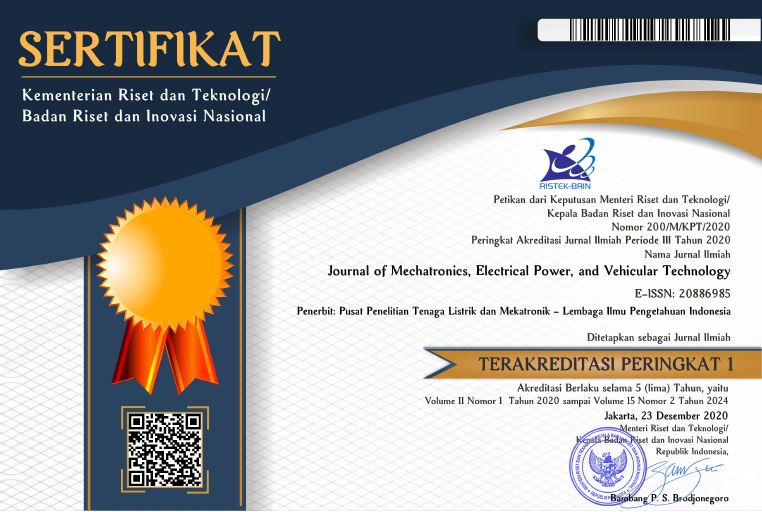Control of mobile robot formations using A-star algorithm and artificial potential fields
Abstract
Formations or groups of robots become essential in cases where a single robot is insufficient to satisfy a given task. With an increasingly automated world, studies on various topics related to robotics have been carried out in both the industrial and academic arenas. In this paper, the control of the formation of differential mobile robots based on the leader-follower approach is presented. The leader's movement is based on the least cost path obtained by the A-star algorithm, thus ensuring a safe and shortest possible route for the leader. Follower robots track the leader's position in real time. Based on this information and the desired distance and angle values, the leader robot is followed. To ensure that the followers do not collide with each other and with the obstacles in the environment, a controller based on Artificial Potential Fields is designed. Stability analysis using Lyapunov theory is performed on the linearized model of the system. To verify the implemented technique, a simulator was designed using the MATLAB programming language. Seven experiments are conducted under different conditions to show the performance of the approach. The distance and orientation errors are less than 0.1 meters and 0.1 radians, respectively. Overall, mobile robots are able to reach the goal position, maintaining the desired formation, in finite time.
Keywords
Full Text:
PDFReferences
K. H. Kowdiki, R. K. Barai, and S. Bhattacharya, “Leader-follower formation control using artificial potential functions: A kinematic approach,” IEEE-International Conf. Adv. Eng. Sci. Manag. ICAESM-2012, pp. 500–505, 2012.
A. Alouache and Q. Wu, “Performance comparison of consensus protocol and l-phi approach for formation control of multiple nonholonomic wheeled mobile robots,” J. Mechatronics, Electr. Power, Veh. Technol., vol. 8, no. 1, pp. 22–32, Jul. 2017.
L. Pacheco and N. Luo, “Testing PID and MPC performance for mobile robot local path-following,” Int. J. Adv. Robot. Syst., vol. 12, no. 11, p. 155, Nov. 2015.
S. Hiroi and M. Niitsuma, “Building a map including moving objects for mobile robot navigation in living environments,” in 2012 Ninth International Conference on Networked Sensing (INSS), Jun. 2012, pp. 1–2.
W.-Y. Lee, K. Hur, K. Hwang, D.-S. Eom, and J.-O. Kim, “Mobile robot navigation using wireless sensor networks without localization procedure,” Wirel. Pers. Commun., vol. 62, no. 2, pp. 257–275, Jan. 2012.
S.-L. Dai, S. He, X. Chen, and X. Jin, “Adaptive leader–follower formation control of nonholonomic mobile robots with prescribed transient and steady-state performance,” IEEE Trans. Ind. Informatics, vol. 16, no. 6, pp. 3662–3671, Jun. 2020.
J. Hirata-Acosta, J. Pliego-Jiménez, C. Cruz-Hernádez, and R. Martínez-Clark, “Leader-follower formation control of wheeled mobile robots without attitude measurements,” Appl. Sci., vol. 11, no. 12, p. 5639, Jun. 2021.
T. Dewi, C. Sitompul, P. Risma, Y. Oktarina, R. Jelista, and M. Mulyati, “Simulation analysis of formation control design of leader-follower robot using fuzzy logic controller,” in 2019 International Conference on Electrical Engineering and Computer Science (ICECOS), Oct. 2019, pp. 68–73.
J. Dong, S. Liu, and K. Peng, “Formation control of multirobot based on I/O feedback linearization and potential function,” Math. Probl. Eng., vol. 2014, pp. 1–6, 2014.
M. A. Kamel and Y. Zhang, “Decentralized leader-follower formation control with obstacle avoidance of multiple unicycle mobile robots,” in 2015 IEEE 28th Canadian Conference on Electrical and Computer Engineering (CCECE), May 2015, pp. 406–411.
H. Xiao and C. L. P. Chen, “Leader-follower consensus multi-robot formation control using neurodynamic-optimization-based nonlinear model predictive control,” IEEE Access, vol. 7, no. 9, pp. 43581–43590, 2019.
H. Xiao, Z. Li, and C. L. Philip Chen, “Formation control of leader–follower mobile robots’ systems using model predictive control based on neural-dynamic optimization,” IEEE Trans. Ind. Electron., vol. 63, no. 9, pp. 5752–5762, Sep. 2016.
Y. Zhao, Y. Zhang, and J. Lee, “Lyapunov and sliding mode based leader-follower formation control for multiple mobile robots with an augmented distance-angle strategy,” Int. J. Control. Autom. Syst., vol. 17, pp. 1314–1321, 2019.
J. Heikkinen, T. Minav, and A. D. Stotckaia, “Self-tuning parameter fuzzy PID controller for autonomous differential drive mobile robot,” Proc. 2017 20th IEEE Int. Conf. Soft Comput. Meas. SCM 2017, pp. 382–385, 2017.
R. Siegwart, I. R. Nourbakhsh, and D. Scaramuzza, Introduction to autonomous mobile robots, 2nd ed. Cambridge, MA: MIT press, 2011.
T. Zhang, P. W. Stackhouse, B. Macpherson, and J. C. Mikovitz, “A solar azimuth formula that renders circumstantial treatment unnecessary without compromising mathematical rigor: Mathematical setup, application and extension of a formula based on the subsolar point and atan2 function,” Renew. Energy, vol. 172, pp. 1333–1340, 2021.
I. M. Zidane and K. Ibrahim, “Wavefront and a-star algorithms for mobile robot path planning,” Adv. Intell. Syst. Comput., vol. 639, pp. 69–80, 2018.
R. L. Galvez et al., “Obstacle avoidance algorithm for swarm of quadrotor unmanned aerial vehicle using artificial potential fields,” in TENCON 2017 - 2017 IEEE Region 10 Conference, Nov. 2017, pp. 2307–2312.
A. Azzabi and K. Nouri, “Path planning for autonomous mobile robot using the potential field method,” in 2017 International Conference on Advanced Systems and Electric Technologies (IC_ASET), Jan. 2017, pp. 389–394.
Article Metrics
Metrics powered by PLOS ALM
Refbacks
- There are currently no refbacks.
Copyright (c) 2021 Journal of Mechatronics, Electrical Power, and Vehicular Technology

This work is licensed under a Creative Commons Attribution-NonCommercial-ShareAlike 4.0 International License.





















